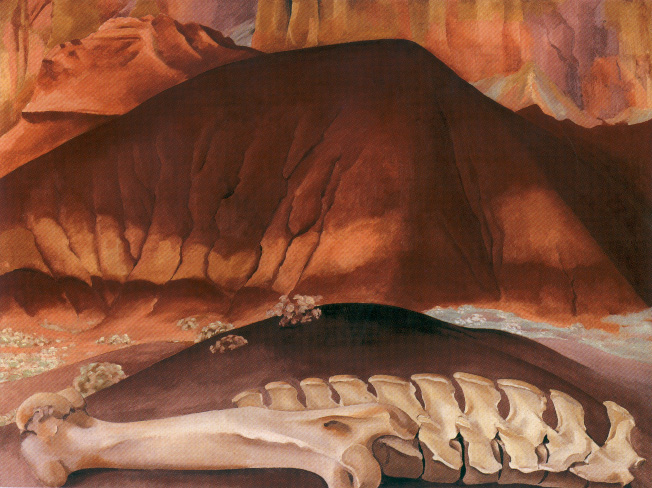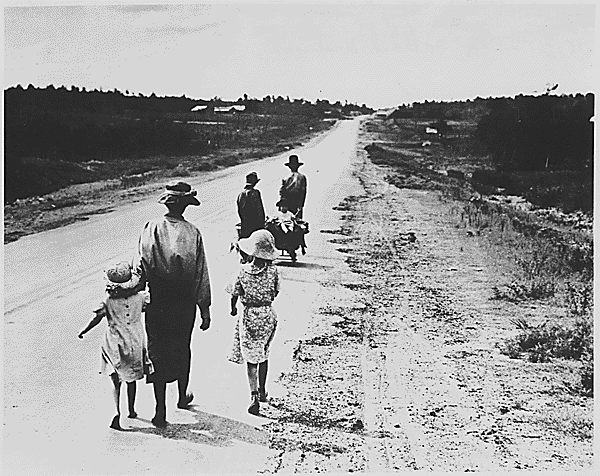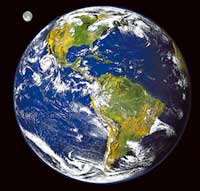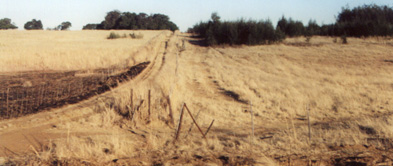 The Dust Bowl, 1933-35.
The Dust Bowl, 1933-35. Bones and Red Hills , by Georgia O'Keeffe (1941) (oil)
Key dates | The Public Domain | The name | Hugh H. Bennet's idea | Interior Secretary Ickes | Immediate Causes
1909, the year Congress tried to induce settlement in one of
the final frontiers of the public domain the arid western half of the Great Plains – with a homestead act that doubled the amount of land a person could plow up and own to 320 acres. The last homestead act was a desperate move, promoted by railroad companies and prairie state senators, to get people to inhabit a place that never held anything more than a few native hunting camps and some thirteenth century Indian villages."
". . . there was supposed to be a dam going up on the Cimarron River in No Man's Land . . ."
p. 4.

"The wind powered the a windmill , which pumped water 140 feet up from the Ogallala Aquifer."
"That was all you needed to stay alive: water and grass."
"Without the wind, there was no water, not cattle, no life."
"Earlier, the land had been overturned in a great speculative frenzy to make money in an unsustainable wheat market. After a big run-up, prices crashed."
p. 5.
By the 1930s, the area was dominated by family farms, called "nesters" who were "sod busters" having plowed up the native short buffalo grasslands to plant wheat, removing the natural defenses afforded by these deeply rooted grasses within less than twenty years, such a fairly short time.
Natural cycles of fire and drought, conspired with settlement of small farms in a tragic series of years with high temperatures, and high winds that soon ripped off the remaining top soil turning it into sand or worse, fine dust.
Dust storms soon were "scattering tons of soil built up over millennia" by the work of bison herds, rodents, coyotes, wolves, and insects in what had been among the most extensive grass-dominated ecological systems in the world.
The resulting disaster killed humans and animals, darkened the skies at noon, and isolated whole towns sweeping fine dust particles as far away as Chicago, Maryland, and Virginia, well over one thousand miles away.
Key dates | The Public Domain | The name | Hugh H. Bennet's idea | Interior Secretary Ickes | Immediate Causes
"The Stock Market Crashed on October 29, 1929, a Tuesday, the most disastrous session on Wall Street to date in a month of turmoil. . . . Over the next three weeks the market lost 40 percent of its value, more than thirty-five billion dollars in shareholder equity. . . .The entire American federal budget was barely three billion dollars."
A four year gain in General Electric stock was wiped out in a month.
p. 73, Egan.
"In southwest Kansas the harvest was up 50 percent in a year. In the county around Dalhart it was up 100 percent. The wheat sat in elevators, in piles; some of it moldered on the ground or blew away."
"At the start of 1930, wheat sold for one-eighth of the high price from ten years earlier. At forty cents a bushel, the price could barely cover costs let alone service a bank note. Across the plains there was only one way out, a last gasp: plant more wheat. Farmers tore up what grass was left, furiously ripping out sod on the hopes that they could hit a crop when the price came back."
"By the end of 1932, one fourth of all the banks would be closed and nine million people would lose their savings."
p. 77.
Key dates | The Public Domain | The name | Hugh H. Bennet's idea | Interior Secretary Ickes | Immediate Causes
" Dust clouds boiled up, ten thousand feet or more in the sky, and rolled like moving mountains – a force of their own."
"The eeriest thing was the darkness"
"There'd be days you couldn't see a hand in front a' your face."
"a storm in May 1934 carried the windblown shards of the Great Plains over much of the nation. In Chicago, twelve million tons of dust fell."
"Cattle went blind and then suffocated . . . . [their] stomachs stuffed with fine sand."
p. 5.
"Children coughed and gagged, dying of something the doctors called "dust pneumonia."pp. 5-6.
You could see it, but they could taste it.
"Its the earth itself, Bam said. The earth is on the move.
Why?
Look what they done to the grass, he said. Look at the land: wrong side up."
" Life without water did strange things to the land."
pp. 114-115.
"The land would not die an easy death. . . . They recorded seventy days days of severe dust storms in 1933."
p. 137, Egan.
"These black northers were the most hated. Life in the galloping flatlands was a pact with nature. It gave as much as it took, and in 1935 it was all take."
p. 175.
Bennett | terminology | dates | photographs | characters | cultures | historical meaning | commentary
"Dust Bowl" was a term used by a reporter to depict hard times and displaced people who lived in the drought-stricken region of the southern plains during the great depression.
The term was first used in a dispatch from Robert Geiger, an AP correspondent in Guymon, Kansas in April of 1935, and the term was used all over the nation.
p. 222, Egan.
The "Dust Bowl Days", also known as the "Dirty Thirties", took its greatest toll on Kansas, Texas and Oklahoma west of the hundredth meridian. The 1930s' decade was full of extremes: blizzards, tornadoes, floods, droughts, and dirt storms.
Key dates | The Public Domain | The name | Hugh H. Bennet's idea | Interior Secretary Ickes | Immediate Causes
Farm in Dalhart Texas, 1938.
"What has happened in this region is tragic beyond belief. . . . a pattern of land use that was basically unsound "
Hugh Hammond Bennett, USSCS,1933.
That son of a Carolina cotton farmer, big Hugh Bennett, continued to rage against the killing of the land by his countrymen."
p. 133, Egan.
Interior Secretary Ickes | The Public Domain | The name | Immediate Causes
The dawn of soil conservation in the US marks a remarkable turn around in federal land and water policy and underscores the mature stage of the conservation of natural resources for these reasons:
- closing of the public domain to homestead settlement by Taylor Grazing Act.
- advent of the Farm Security Administration and soil banking.
- Multi-use -- Federal water projects such as TVA and the Columbia River for electricity (power), flood control, irrigation, fisheries and recreation.
- Duck stamp program for the purchase of wildlife preserves.
- Ecological Society of America promoted remnant landscape identification and protection steps (purchase or reserve).
- desertification, migration and foreclosures altered the culture.
- Protection of National Parks (Everglades) for other than scenic reasons.
- Spurred Rural electrification, afforestation, and reforestation programs.
Key dates | The Public Domain | The name | Hugh H. Bennet's idea | Interior Secretary Ickes | Immediate Causes
Harold Ickes, Secretary of the Department of the Interior:
"As Interior Secretary, he was emperor of the outdoors, in charge of a public domain nearly the size of Germany (old Germany). In his view, the land was spent; the drought was simply the deathblow. It was hard to tell people that their earnest agricultural toil had brought them great woe, but Ickes did...."
p. 225, Egan.
| The New Deal | |
|---|---|
| Franklin Delano Roosevelt | |
|
Technology
that saved the plains |
(January 30, 1882 – April 12, 1945) |
|
Soil banking to invest in fallow fields and building up nutrients |
"How much do the shallow thinkers realize that approximately one half of our population, fifty of sixty million people, earn their living by farming or in small towns where their existence immediately depends on farms? They have today lost their purchasing power. Why? They are receiving less than the cost to them of growing these farm products." March 12th, 1933 |
| Afforestation, planting wind breaks | |
| Farm Price supports | |
| crop rotation, contour plowing | |
| Rural Electrification | |
| Soil Conservation Districts and the Soil Conservation Service | |
|
The Agricultural Adjustment Act created the framework, and the Civilian Conservation Corps drummed up the foot soldiers. They would try to stitch the land back together. Build dams, bridges. Restore forests. Keep water from running away. Build trails in the mountains, roads on the prairie, lakes and ponds. In May, Roosevelt signed a bill giving two hundred million dollars to help farmers facing foreclosure. Now, before some nester's land could be taken to satisfy a bank loan, there was a place of last resort." p. 133. |
|
|
The
long dust trail west: refugees on the high plains, 1934-36. (Credit:
Great
Depression, Library, Think-Quest, collection) |
|
Interior Secretary Ickes | The Public Domain | The name | Immediate Causes
"Roosevelt signed Executive Order 7028, granting federal authorities the power to buy back much of what had been given away in homesteads over the previous seventy-three years. . . . was a stunning reversal of everything the government had done with the public domain since the founding of the republic."
p. 229.
Egan, The Worst Hard Times
Compared to other authors:
Cultural Transformations
"Americans had discovered culture in the 1920s, and by the Depression decade, the attempt to define a unique American way of life in cultural terms was well underway. Several forces introduced Americans to the concept of culture. America's growing prominence in the world arena, the emergence of the social sciences, particularly anthropology, the spread of new media (photographs, film, radio, mass circulation magazines like Time and Life), and the resurgence of an old medium (cheap books! for all meant that Americans began to read more non-fiction than fiction in the 1930s). These changes prompted Americans to look at themselves in ways that they had never done before.
Two anthropological works, Stuart Chase' Mexico: A Study of Two Americas (1931) and Ruth Benedict's Patterns of Culture (1934) strongly influenced American views towards culture.
So too did historical romance novels, with Margaret Mitchell's Gone With the Wind (1936–an imitation of Thackery's Vanity Faire–) leading the way. Media, literature, non-fiction and photography introduced Americans to other ways of life (in Mitchell's case, the American South, which even today remains somewhat mysterious to many Americans)".
John Steinbeck's Tortilla Flats, and the Grapes of Wrath, and William Faulkner's novels introduced Americans to the western and southern extremes of both character and characterizations of distinct cultural patterns native to the western and southern borderlands. They are examples of just two outstanding novelists who called attention to impact of the agrarian depression and the accompanying cultural changes the collapse of this older, traditional way of life brought to the nation's attention.
The Federal Writer's Project to employ unemployed artists and poets in the Great Depression created a lasting body of theatrical works, radio shows, oral histories, and photographic documentation of the nation's history since the Civil War.
"In the words of American cultural historian Warren I. Susman:
"Americans began ... thinking in terms of patterns of behavior and belief, values and life-styles, symbols and meanings. It was during this period that we find, for the first time, frequent reference to an 'American Way of Life.' The phrase 'The American Dream' came into common use; it meant something shared collectively by all Americans; yet something different than the vision of an American Mission, the function of the organized nation itself.
(Culture as History, p. 154.)
In one sense, Americans were trying to define their civilization in relation to the other great civilizations of history.
And, rather than reject the 'marginal man' in their midst, Americans began to incorporate him – and her – into their cultural definition of an 'American'."
• quoted sections from: Department of History, Ohio State University,
Frank Galati " Adaptation of John Steinbeck" The Grapes of Wrath -Spring 2001, written by Bill Childs.
Interior Secretary Ickes | The Public Domain | The name | Immediate Causes
1929, October the stock market fell from which it not soon recovered.
"1930 was dry but most of the farmers made a wheat crop."
1930-1931, "After the blizzards in winter . . .the drought began."
In 1931 the wheat crop was considered a bumper crop with over twelve million bushels of wheat. Wheat was everywhere, in the elevators, on the ground and in the road.
The wheat supply forced the price down from sixty-eight cents/bushel in July 1930 to twenty-five cents/bushel in July 1931.
"Many farmers went broke and others abandoned their fields."
January 1933, the region was blasted by a . . . dirt storm which killed much of the wheat."
1934 to 1936, three record drought years for the nation.
1935, a more severe storm spread out of the plains and across most of the nation."
1936, the number of dirt storms increased and the temperature broke the 1934 record high by soaring above 120 degrees.
1936, the fall rains began to return and the heat wave was broken.
1937 was another year of unprecedented dirt storms and the usual floods.
1938 was the year of the "snuster". The snuster was a mixture of dirt and snow reaching blizzard proportions.
Interior Secretary Ickes | The Public Domain | The name | Immediate Causes
"The storm caused a tremendous amount of damage and suffering."
Excerpts from "The Dust Bowl, Men, Dirt and Depression" by Paul Bonnifield.
"On April 14, 1935, a freakish storm barreled through the Texas Panhandle, sweeping up 300,000 tons of topsoil."
"Still, most Americans weren't really paying much attention to the state's winds until May 1934, two years after the start of the worst round of drought-driven dust storms since the 1890s," Knapp said. "High-level winds gathered enough momentum and soil to send 350 million tons of dirt as fast as 100 mph toward the East Coast.
"The wind currents dumped an estimated 12 million tons of silt over Chicago. A day later, dust shrouded New York City for hours. Then it sprinkled ships more than 300 miles offshore," Knapp said. "The storm originated in Montana and Wyoming, but East Coast papers called it 'Kansas dirt.' A year later, the Dust Bowl got its name from a day still known in Kansas as Black Sunday."
Robert Geiger, an Associated Press correspondent said Kansas farmers' desperate hopes for rain "rule life in the dust bowl of the continent."
"Even as Egan blames farming for ravaging the land, his portraits of individual farmers and families are tenderly poignant."
- Hazel Lucas Shaw, a school teacher and young mother, is brave and tragic, betrayed by the land she loves when her baby daughter and grandmother die within hours of each other of dust pneumonia.
- Bam White, cowboy (1926) turned ambivalent farmer, becomes a star-crossed icon for the farmers when the government puts him in a movie aimed at justifying the enormous federal government intervention in the region.
"The Worst Hard Time"
- How much did the government's plan to plant trees help?
- How did farming patterns change?
- What happened the next time drought rolled around?
Timothy Egan "has created a cautionary tale of what ignorance and greed can do to the land that must sustain us, and how present government policies might create it once again."
" How could people survive this?"
"Egan has admirably captured a part of our American experience that should not be forgotten."
Elizabeth Corcoran is a contributing editor at Forbes magazine.
"The Worst Hard Times" ends before this failure, but not before Egan, in an epilogue, gets in a quick dig against destructive federal subsidies and Texans' depleting the Ogallala aquifer. You can't blame him for feeling angry. The High Plains have never fully recovered.
Book Review.
Interior Secretary Ickes | The Public Domain | The name | Immediate Causes
Land and labor inherent in wealth

Environmental science of the dust bowl.
Interior Secretary Ickes | The Public Domain | The name | Immediate Causes

This page was created, by J. Siry based on Egan's The Worst Hard Times.









